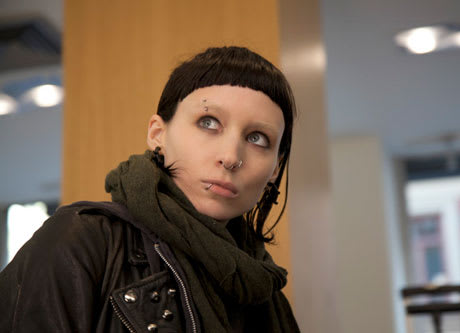Daniel Craig's Mikael Blomkvist does most of the investigative heavy lifting. Christopher Plummer's Henrik Vanger is the head of the corrupt family whose mysteries Blomkvist is trying to unearth. And the titular character doesn't get involved in this central mystery until more than halfway through the movie. But it is Lisbeth Salander ― tiny, pierced and angry, a brilliant researcher and damaged soul, as portrayed by relative newcomer Rooney Mara ― who leaves an indelible impression in The Girl With the Dragon Tattoo.
Director David Fincher (The Social Network, Fight Club), working from a script by Oscar winner Steven Zaillian, based on the hugely successful trilogy from Swedish novelist Stieg Larsson, does a deft job of handling two different narratives. The primary one is of Blomkvist, a famous journalist whose career has been derailed after attacking a prominent industrialist, being hired by Henrik Vanger to solve a 40-year-old mystery: what happened to his young niece, whom Vanger believes was a victim of one of his powerful, Nazi-sympathizing family members. Meanwhile, 24-year-old Salander, a ward of the Swedish state, with a lifelong history of violence and mental instability, battles against her handlers, at least one of whom exploits her weakness for his sexual satisfaction.
Salander resists conventional Swedish society, but her skills as a hacker and researcher are unparalleled; when Blomkvist wants to hire her, his pitch is to help him find "a killer of women," which fits perfectly into Salander's quests for justice. Together, Salander and Blomkvist form an unconventional team ― he the blonde, blue-eyed stoic journalist, her the scary, underground-dwelling rebel ― but the relationship is so compelling that it almost overshadows the mystery they're ostensibly trying to solve in this first film.
Fincher is clearly as invested in Salander and Blomkvist's relationship ― and the foundations of what's to come in Larsson's subsequent novels ― as he is in unravelling the evils hidden within the Vanger family. He spends more than half the movie establishing Salander as a brilliant researcher and damaged victim of powerful authority figures in her life; less time is spent on Blomkvist's role at Millennium magazine (and his relationship with its publisher, played by Robin Wright), which would play a greater role in subsequent films. Stylistically, he doesn't go "full Fincher" ― seemingly gone since Benjamin Button is the near-darkness cinematography ― and like in Zodiac and The Social Network, the director's fascination with processes provides both tension and character insight. He just likes to watch talented people do good work, and that extends not just to characters, but also to actors like Mara.
The biggest stylistic flourish in fact comes from the opening credits ― a cool series of liquid metal images morphing between keyboards and humanoid figures, all set to Led Zeppelin's "Immigrant Song," as interpreted by Karen O and soundtrack composers Trent Reznor (Nine Inch Nails) and Atticus Ross.
Director David Fincher (The Social Network, Fight Club), working from a script by Oscar winner Steven Zaillian, based on the hugely successful trilogy from Swedish novelist Stieg Larsson, does a deft job of handling two different narratives. The primary one is of Blomkvist, a famous journalist whose career has been derailed after attacking a prominent industrialist, being hired by Henrik Vanger to solve a 40-year-old mystery: what happened to his young niece, whom Vanger believes was a victim of one of his powerful, Nazi-sympathizing family members. Meanwhile, 24-year-old Salander, a ward of the Swedish state, with a lifelong history of violence and mental instability, battles against her handlers, at least one of whom exploits her weakness for his sexual satisfaction.
Salander resists conventional Swedish society, but her skills as a hacker and researcher are unparalleled; when Blomkvist wants to hire her, his pitch is to help him find "a killer of women," which fits perfectly into Salander's quests for justice. Together, Salander and Blomkvist form an unconventional team ― he the blonde, blue-eyed stoic journalist, her the scary, underground-dwelling rebel ― but the relationship is so compelling that it almost overshadows the mystery they're ostensibly trying to solve in this first film.
Fincher is clearly as invested in Salander and Blomkvist's relationship ― and the foundations of what's to come in Larsson's subsequent novels ― as he is in unravelling the evils hidden within the Vanger family. He spends more than half the movie establishing Salander as a brilliant researcher and damaged victim of powerful authority figures in her life; less time is spent on Blomkvist's role at Millennium magazine (and his relationship with its publisher, played by Robin Wright), which would play a greater role in subsequent films. Stylistically, he doesn't go "full Fincher" ― seemingly gone since Benjamin Button is the near-darkness cinematography ― and like in Zodiac and The Social Network, the director's fascination with processes provides both tension and character insight. He just likes to watch talented people do good work, and that extends not just to characters, but also to actors like Mara.
The biggest stylistic flourish in fact comes from the opening credits ― a cool series of liquid metal images morphing between keyboards and humanoid figures, all set to Led Zeppelin's "Immigrant Song," as interpreted by Karen O and soundtrack composers Trent Reznor (Nine Inch Nails) and Atticus Ross.
